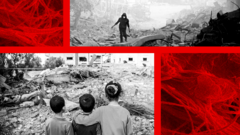The exposure to asbestos in Gaza's rubble remains a silent yet deadly threat to the population, potentially leading to severe diseases decades after initial contact.
**Asbestos Crisis: The Hidden Peril Amid Conflict in Gaza**

**Asbestos Crisis: The Hidden Peril Amid Conflict in Gaza**
Amid ongoing hostilities, experts warn of asbestos risk from destroyed structures in Gaza, with dire long-term health consequences for residents.
The destruction caused by Israel's military operations in Gaza has unearthed a hidden danger: asbestos. Once a common component in construction materials, the mineral is notorious for releasing toxic fibers into the air, which can lead to serious lung conditions, including cancer. Although it has been banned in many countries, remnants of asbestos remain prevalent in older buildings across Gaza, especially in the roofs of urban refugee camps established for Palestinians displaced during the 1948-49 Arab-Israeli war, according to the United Nations Environment Programme (UNEP).
As of October 2024, UNEP estimated that approximately 2.3 million tons of debris in Gaza may be contaminated with asbestos. Professor Bill Cookson from London's National Centre for Mesothelioma Research described the situation as "very, very toxic," emphasizing that exposure will not only affect individuals in the short term but could also leave lasting health issues for children and future generations. Liz Darlison, CEO of Mesothelioma UK, echoed this concern, noting that the consequences will extend well beyond the current conflicts.
The dangers arise when asbestos is disturbed—such as during airstrikes—releasing microscopic fibers into the air that can be inhaled. Even tiny amounts can result in diseases like asbestosis and mesothelioma, which can take 20 to 60 years to develop post-exposure. "The worrying aspect of mesothelioma," Professor Cookson remarked, "is that it's not dose related," meaning no exposure is deemed safe.
For residents of Gaza—a densely populated area of around 2.1 million people living in just 365 square kilometers—avoiding asbestos exposure is virtually impossible. Medical personnel in Gaza indicate that current life-threatening events overshadow long-term health risks. Chiara Lodi, medical coordinator for Medical Aid for Palestinians, highlights that the Iraqi population cannot envision asbestos inhalation as a pressing concern when faced with dire shortages of food and protection from ongoing violence.
With a lack of awareness about the risks associated with asbestos and dust, residents struggle to take necessary precautions. Past conflicts have revealed the presence of asbestos in debris from older constructions, suggesting a persistent risk to health and safety in rebuilding efforts. The hazardous types of asbestos found vary in danger levels, with crocidolite being among the most carcinogenic.
The management of debris in Gaza is crucial, as recommended by UNEP. Improper handling could disturb contaminated rubble and release hazardous fibers back into the environment. Clearances could take up to 21 years and cost around $1.2 billion, highlighting the complexities involved in addressing this critical issue as reconstruction plans unfold amidst ongoing conflict.
As violence continues, the long-term health implications of asbestos exposure could become an even greater crisis than the immediate dangers posed by the war itself. In a tragic parallel, the aftermath of the 9/11 attacks serves as a stark reminder of how exposure to toxic dust can have devastating impacts, raising alarms about the catastrophic consequences that may await Gaza years down the line. As reconstruction debates heat up between global leaders, experts stress the urgency of handling the debris crisis with extreme care to safeguard the health of the affected populace.
As of October 2024, UNEP estimated that approximately 2.3 million tons of debris in Gaza may be contaminated with asbestos. Professor Bill Cookson from London's National Centre for Mesothelioma Research described the situation as "very, very toxic," emphasizing that exposure will not only affect individuals in the short term but could also leave lasting health issues for children and future generations. Liz Darlison, CEO of Mesothelioma UK, echoed this concern, noting that the consequences will extend well beyond the current conflicts.
The dangers arise when asbestos is disturbed—such as during airstrikes—releasing microscopic fibers into the air that can be inhaled. Even tiny amounts can result in diseases like asbestosis and mesothelioma, which can take 20 to 60 years to develop post-exposure. "The worrying aspect of mesothelioma," Professor Cookson remarked, "is that it's not dose related," meaning no exposure is deemed safe.
For residents of Gaza—a densely populated area of around 2.1 million people living in just 365 square kilometers—avoiding asbestos exposure is virtually impossible. Medical personnel in Gaza indicate that current life-threatening events overshadow long-term health risks. Chiara Lodi, medical coordinator for Medical Aid for Palestinians, highlights that the Iraqi population cannot envision asbestos inhalation as a pressing concern when faced with dire shortages of food and protection from ongoing violence.
With a lack of awareness about the risks associated with asbestos and dust, residents struggle to take necessary precautions. Past conflicts have revealed the presence of asbestos in debris from older constructions, suggesting a persistent risk to health and safety in rebuilding efforts. The hazardous types of asbestos found vary in danger levels, with crocidolite being among the most carcinogenic.
The management of debris in Gaza is crucial, as recommended by UNEP. Improper handling could disturb contaminated rubble and release hazardous fibers back into the environment. Clearances could take up to 21 years and cost around $1.2 billion, highlighting the complexities involved in addressing this critical issue as reconstruction plans unfold amidst ongoing conflict.
As violence continues, the long-term health implications of asbestos exposure could become an even greater crisis than the immediate dangers posed by the war itself. In a tragic parallel, the aftermath of the 9/11 attacks serves as a stark reminder of how exposure to toxic dust can have devastating impacts, raising alarms about the catastrophic consequences that may await Gaza years down the line. As reconstruction debates heat up between global leaders, experts stress the urgency of handling the debris crisis with extreme care to safeguard the health of the affected populace.




















